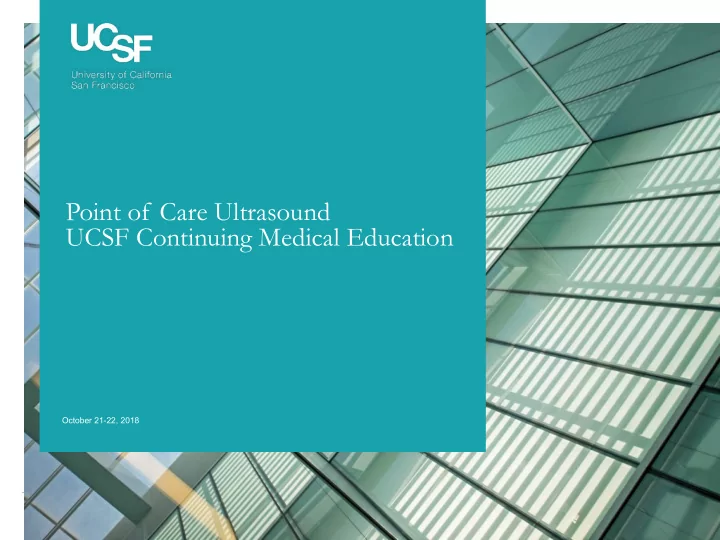

Point of Care Ultrasound UCSF Continuing Medical Education October 21-22, 2018
Disclosure I have no relevant financial relationships with any companies related to the content of this course.
Lung Ultrasound and Thoracentesis Stephanie Conner, MD UCSF Medical Center at Parnassus Heights 3
Objectives • Basic principles of lung ultrasound • Key findings with lung ultrasound • Overview of thoracentesis 4
Probe Selection 10-15 MHz Linear Phased Array Curvilinear 25 mm 5
Patient Position Chest. 2011;140(5):1332-1341. doi:10.1378/chest.11-0348 6
Hospitalized Patient Technique Interstitial findings • • Anterior: A or B lines Lateral Bases: normal to • have some B-lines Look for effusions • Probe orientation • • Vertical (longitudinal) • Midclavicular line � posterior axillary line Used with permission from Arun Nagdev
Findings on lung ultrasound • Normal Lung • Alveolar and interstitial changes (pulmonary edema, fibrosis, etc.) • Consolidation • Pleural Effusion • Pneumothorax 8
Findings, continued A-Lines B-lines Pneumothorax Effusions Consolidations 9
A Lines and B Lines • Curvilinear or Phased Array Probe • Increase Gain • Depth 12-16cm 10
Normal Lung • Normal aerated lung scatters ultrasound waves, can’t be seen • A-lines are horizontal hyper echoic lines representing artifact: reverberations between the highly reflective pleura and transducer 11
12
A lines = non-thickened interstitial septa 13
Alveolar Interstitial Changes • Widening of the interlobular septa allows for propagation of ultrasound waves and the formation of b-lines. • Seen in pulmonary edema, PNA, ARDS, ILD 14
“B” Lines Rib Rib Tissue Air/Water Interface 15
Move with lung sliding Arise from the pleural line 3 per rib space Well-defined B lines = interstitial Reach screen edge syndrome Acute Interstitial Syndrome 16
Lung US: Dynamic Monitoring Liteplo et al. Real-time resolution of sonographic B-lines in a patient with pulmonary edema on CPAP. AJEM (2010) Case: Hx CHF, ESRD, • dyspnea, orthopnea Initial US: Diffuse B-lines • After CPAP x 3.5hrs: A-lines • 17
Review A-lines vs B-lines A -Lines B -Lines Which Probe? Curvilinear or Phased Array Scan Where? Anterior Midclavicular CHF PNA What are B-lines? Interstitial Syndrome ARDS Are B-lines pathologic in lateral zones? Fibrosis NO! 18
Alveolar Consolidation • “Hepatization of lung” • 98.5% PNAs abut pleura • US vs CT: (Lichtenstein 2007) • Sens: 0.91 • Spec: 0.98 19
Case: 50 y/o male with cough & fever Liver 20
Pleural Effusion • Identification of a hypoechoic or echo-free space surrounded by typical anatomic boundaries: • diaphragm (and abdominal organs) • chest wall • Ribs • visceral pleura • normal/consolidated/atelectatic lung 21
Positioning Start South then Go North 22
RUQ/Perihepatic view: Normal Morison’s Pouch Diaphragm Costophrenic Recess 23
Pleural Effusion 24
Pleural Effusion • US more sensitive than XR or exam: Exam > 300mL • CXR >200mL • • US > 20 mL Liver Effusion • Scan dependent zones Fluid is hypoechoic (black) • • Large effusions generally more symptomatic Lung 25
Simple vs complex effusions 26
Consolidation and Effusion Summary • More sensitive than physical exam or X-ray • Faster to acquire than CXR • Less radiation 27
Pneumothorax 28
Probe Selection 10-15 MHz Linear Curvilinear 25 mm 29
Normal Lung: Sliding Visceral Pleura Rib Alveoli Rib Shadow Slide used with permission of Arun Nagdev 30
Is Pleural Sliding Present? 31
Pneumothorax Is Pleural Sliding Present? 32
33
Normal M-mode of Lung Soft Ocean Tissue Normal Beach Lung 34
Abnormal Lung M-mode: PNEUMOTHORAX Soft Tissue Ocean / Barcode Abnormal Lung 35
Confirm: M-Mode OVERVIEW No Pneumothorax Pneumothorax Ocean + Beach Ocean 36
The Lung Point • Sensitivity: 0.66 • Specificity: 1.00 (Lichtenstein 233 ICU pts vs CT) 37
38
US: Pneumothorax • Outperforms CXR in supine patients • Much higher sensitivity, similar specificity • Lower specificity critically ill ICU patients • False positives with pulmonary scarring, TB, ARDS (specificity 60-91%) • Lung Point: 100% specificity 39
Lung US Review • A-Lines: R/O CHF. Likely COPD/PE/Normal • B-Lines: Diffuse: CHF, ARDS, PNAs. • B-Lines: Focal: PNA • Hepatization likely consolidation • Effusions: scan posterior and lateral bases. Find the diaphragm! • Pneumothorax: absence of lung sliding, lung point highly specific 40
Thoracentesis 41
42
US Guidance in Thoracentesis • Find fluid on ultrasound • Establish landmarks for safe needle insertion with adequate depth • Usually not done under direct US guidance • Check for lung sliding after the procedure 43
Safe for thoracentesis? 44
Safe for thoracentesis? 45
Recommend
More recommend